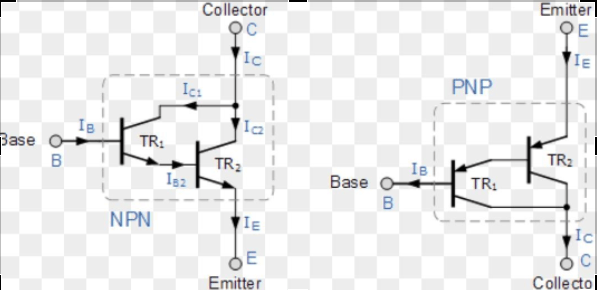
Darlington transistor is a back to back connection of two NPN or PNP Bipolar Junction Transistors(BJT). As shown in figure the Emitter of one transistor is connected to the base of other transistor.
Darlington transistor was invented by Sidney Darlington in the year of 1953.
A Darlington transistor configuration also known as “Darlington pair” or “Super-Alpha circuit“.
Now Darlington pair available in a single package with standard Base, Emitter and collector leads. It acts like a single transistor that has high current gain and high input impedance being used in application where current amplification or switching is required.
Considering NPN transistor only a small current is required to make first transistor TR1 in to conduction mode. The output of TR1 is the input of second transistor TR2. So the amplified current from the first transistor is again amplified by the current gain of the second transistor. Therefore the Emitter current of TR2 is very large enough to drive high loads.
Current gain of a transistor is the ratio of Collector current (IC) to Base current(IB). Suppose if the current gain of TR1 is B1 and current gain of transistor is B2.
Then current gain of TR1
B1=IC1/IB1
Then,
IC1=B1 . IB1
Current gain of TR2
B2=IC2/IB2
Then,
IC2=B2 . IB2
Total collector current
IC=IC1+IC2
=B1 . IB1+ B2 . IB2
But,
IB2=IB+IC1
=IB+B1 . IB
=IB(1+B1)
Then
IC=B1 IB+B2 IB(1+B1)
=IB(B1+B2+B1 B2)
Neglecting individual gains Then,
IC= IB(B1 B2)
Therefore
B=(B1 B2)
For a normal transistor B value is 100
So,
B=100×100
=10000
This tells that current available to drive the load is 100 times of the input current.
ADVANTAGES
- It has very high current gain compared to single transistor. So that only small base current is needed to make the transistor switch on.
- It has high input impedance
DISADVANTAGES
- Almost doubling the Base Emitter voltage ( VBE=VBE1+VBE2), because of that it can get heat up than a single BUT
- Because of minimum voltage drop between the Base and Emitter when fully saturated, switching speed is low.
- The total leakage current is high because leakage current of first transistor is amplified by the second transistor.
APPLICATIONS
Because of high current gain at small base current Darlington pair is very useful in most of the applications. These are used in applications where frequency of response is low such as power regulators, motor controllers, audio amplifier, low side switches, sensor amplifier etc….
Created by: Technical writer Anju Radhakrishnan